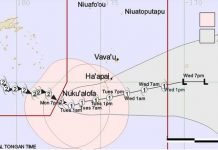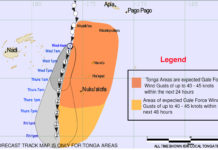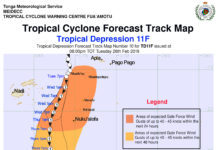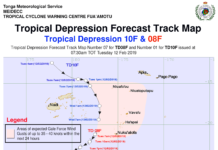A large water funnel resembling a tornado was seen in the south-western sea of Tonga from the Blow Holes coastline at the village of Houma yesterday.
Amateur footages captured by Dr Sayri Kawamura, a project manager of the Malimali Dental project in Tonga, shows a whirling column of air and water formed in the ocean.
The images were uploaded this morning to Facebook and below was one of the captions:
“15th Feb 2014–Picture taken by Dr Sayuri Kawamura of the SPMT(Japan) AT THE SEA NEAR THE BLOW HOLES–saw this funnel cloud rotating cone-shaped column extending downward from the base of the cloud touching the sea creating this oval shaped waterspouts—"
Sesilia Fifita was at the scene and she said it, “was a shock seeing this tiny tornado”.
Experts said water spouts could cause winds averaging between 120 – 200km/h.
About waterspout:
[Retrieved from oceanservice.noaa.gov] Waterspouts fall into two categories: fair weather waterspouts and tornadic waterspouts.
Tornadic waterspouts are tornadoes that form over water, or move from land to water. They have the same characteristics as a land tornado. They are associated with severe thunderstorms, and are often accompanied by high winds and seas, large hail, and frequent dangerous lightning.
Fair weather waterspouts usually form along the dark flat base of a line of developing cumulus clouds. This type of waterspout is generally not associated with thunderstorms. While tornadic waterspouts develop downward in a thunderstorm, a fair weather waterspout develops on the surface of the water and works its way upward. By the time the funnel is visible, a fair weather waterspout is near maturity. Fair weather waterspouts form in light wind conditions so they normally move very little.
If a waterspout moves onshore, the National Weather Service issues a tornado warning, as some of them can cause significant damage and injuries to people. Typically, fair weather waterspouts dissipate rapidly when they make landfall, and rarely penetrate far inland.






